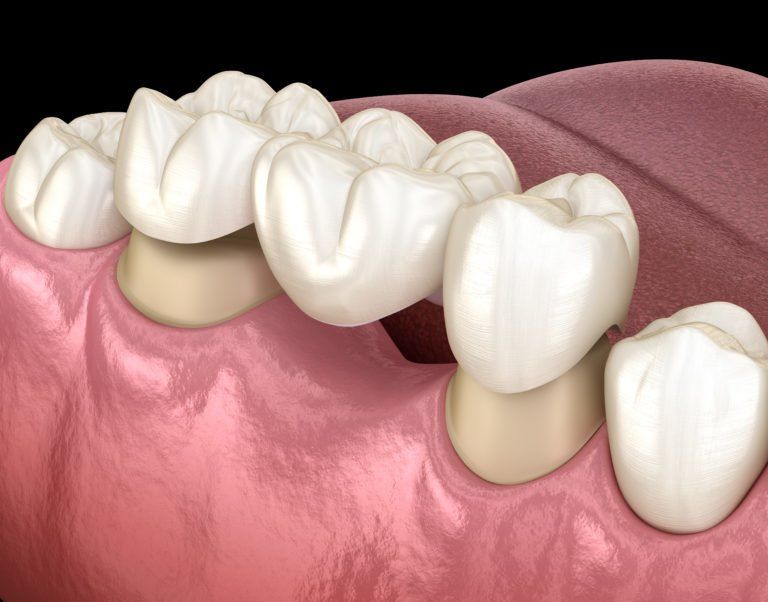DENTAL BRIDGES
Dental bridges are a great option for dental restoration for people who are missing teeth. At Gateway Family Dentistry in Murfreesboro, Tenn., we strive to provide education, comfort and expert follow-up care for all our patients.
What is a Dental Bridge?
A traditional dental bridge
uses two or more connected crowns to create a bridge across the gap left by a missing tooth or teeth. The bridge contains a “pontic” tooth that fits into that gap. Bridges require either healthy natural teeth or dental implants on either side of a missing tooth to create a secure anchor for a pontic tooth. Unfortunately, the surrounding teeth have to be shaped for the placement of the bridge. There are additional types of bridges that your dentist may recommend; we explain them below.
Tooth being fitted with a bridge
Why Choose a Dental Bridge?
When you lose a tooth, the shape of your jaw and the position of your remaining teeth can change and shift. This movement can place stress on the bones and muscles in the jaw. It can also affect how the jaw, cheeks and lips look.
When tooth loss occurs, tooth replacement is almost always recommended. Replacement serves not only aesthetic purposes, but also provides stability for the rest of the teeth and the jaw bone. The most common options for tooth replacement are dental implants, dentures and dental bridges.
Dental implants
are considered the gold standard
of tooth replacement because they function most similarly to natural teeth.
However, there are some instances when a dental implant is not the best option.
For patients without sufficient bone mass to support a dental implant, a bridge may be recommended. Additionally, a dental bridge costs less money and can be acquired more quickly than a dental implant.
A dental bridge uses two or more connected crowns to create a bridge across the gap left by a missing tooth or teeth. The bridge contains a “pontic” tooth that fits into that gap. Bridges require either healthy natural teeth or dental implants on either side of a missing tooth to create a secure anchor for a replacement tooth. Unfortunately, the surrounding teeth have to be shaped for the placement of the bridge.
What Are the Different Kinds of Dental Bridges?
There are four different types of dental bridges: traditional dental bridges, Maryland bonded bridges, implant-supported dental bridges and cantilever dental bridges.
- Traditional dental bridges, as detailed above, secure a pontic (replacement) tooth with two or more crowns on either side of a missing tooth.
- Cantilever dental bridges work similarly to traditional bridges. However, the pontic tooth in a cantilever dental bridge is secured by only one crown. Additionally, cantilever dental bridges require only one healthy tooth beside the space left by a missing tooth.
- Maryland bonded dental bridges secure a false tooth in the space left by a missing tooth by bonding “wings” to the back of the teeth on either side of the gap. The wings are generally made of metal. The Maryland bridge does not require filing or reshaping of healthy teeth.
- Implant-supported dental bridges function the same as traditional dental bridges. However, the pontic tooth is supported by dental implants and not natural teeth.
Every dental bridge procedure requires a unique investment of time and money.
If you’re in need of tooth replacement, and you’re interested in a dental bridge procedure, Gateway Family Dentistry in Murfreesboro can help you.
Contact us today to learn more or to schedule your appointment.



